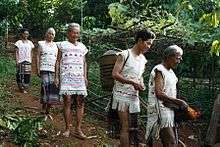Mạ people
The Mạ or Maa (Vietnamese: Người Mạ) are a Mon–Khmer-speaking people in Vietnam (population 50,322 in 2019). They are concentrated mostly in the Lâm Đồng Province of the country, particularly in the area of the upper Đồng Nai River in the western part of the province.[2]
 | |
| Total population | |
|---|---|
| Regions with significant populations | |
| Vietnam | |
| Languages | |
| Mạ, Vietnamese, others | |
| Religion | |
| Theravada Buddhism |
The Ma achieved some form of political unity and a stratified society before the 19th century due to the influence of the Phù Nam.[2] This, however, broke down due to varying factors such as the French colonization, inter-group warfare, and slave trading.[2] The Mon-Khmer-speaking group called Cho Ro is identified by some ethnologists as a subgroup of the Ma people.[3] These also reside in the Đồng Nai Province in southern Vietnam within the vicinity of the Mekong delta and Ho Chi Minh City.[3]
Culture
Language
The Mạ or Maa language comes under the Mon-Khmer Group: this and the Koho language are sometimes considered to be different dialects only.[4] Lê et al. lists the following Mạ subgroups.[5] There are over 16,000 Mạ people living in Lộc Thắng, Lộc Bắc, Lộc Tân, Lộc Lâm, Lộc Ngãi, and Lộc Châu communes in Bảo Lộc District; Đạ Teh, Đạ M’rê, Đạ Huoai, Đồng Nai, and Ma Đa Gui communes in Đạ Huoai District; Đạ Đờn and Phú Sơn communes in Đức Trọng District; Đinh Trang Thượng commune in northern Di Linh District (Lê et. al 2014:310). These districts all belong to Lâm Đồng Province.
- Mạ Ngăn: the main Mạ subgroup, who live in the Đạ Đơng river basin. Lộc Bắc, Lộc Trung, Lộc Lâm communes of Bảo Lộc District, Lâm Đồng Province.
- Mạ Tô: in upstream La Ngà (Đạ Rnga) River, Blao (Bảo Lộc) plateau. Many are in close contact with the Koho people.
- Mạ Krung: in the southern plains, from southeastern Bảo Lộc District, Lâm Đồng Province to Định Quán District, Đồng Nai Province
- Mạ Xốp: in Lộc Bắc commune, Bảo Lộc District, and some in Lộc Trung commune of the same district.
Le (2003)[6] covers the Maa varieties of Dagui, Chop, and Tadung.
Folklore
The Mạ have a rich oral traditions, and their culture is a tapestry of folklore. Myths, parables, and legends are an integral part of this ethnic group.[7]
Traditional attire
The Mạ are also known for their traditional colorful attire. Mạ women wear skirts that reach well below their knees. The men customarily wear loincloth.
References
- "Report on Results of the 2019 Census". General Statistics Office of Vietnam. Retrieved 1 May 2020.
- Howard, Michael (2016). Textiles and Clothing of Việt Nam: A History. Jefferson, NC: McFarland Company, Inc., Publishers. p. 175. ISBN 9781476663326.
- Michaud, Jean; Swain, Margaret; Barkataki-Ruscheweyh, Meenaxi (2016). Historical Dictionary of the Peoples of the Southeast Asian Massif, 2nd edition. Lanham, MD: Rowman & Littlefield. p. 102. ISBN 9781442272781.
- Ethnologue: Maa
- Lê Bá Thảo, Hoàng Ma, et al. (2014) Viện hàn lâm khoa học xã hội Việt Nam - Viện dân tộc học. 2014. Các dân tộc ít người ở Việt Nam: các tỉnh phía nam. Ha Noi: Nhà xuất bản khoa học xã hội. ISBN 978-604-90-2436-8
- Le, Tan Duong (2003) A phonological comparison of Maa and Koho varieties. Master’s thesis, Payap University.
- "54 Ethnic People of Vietnam". Retrieved 1 January 2013.